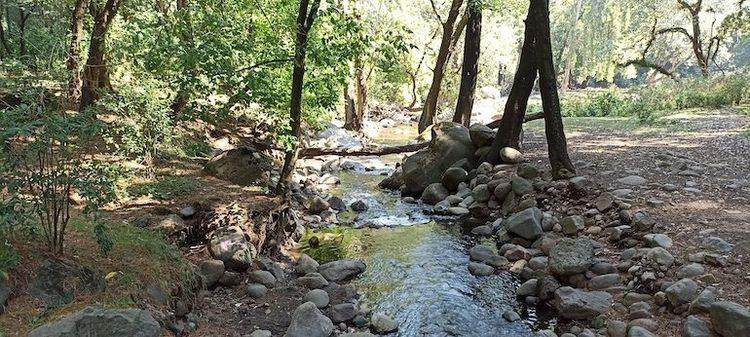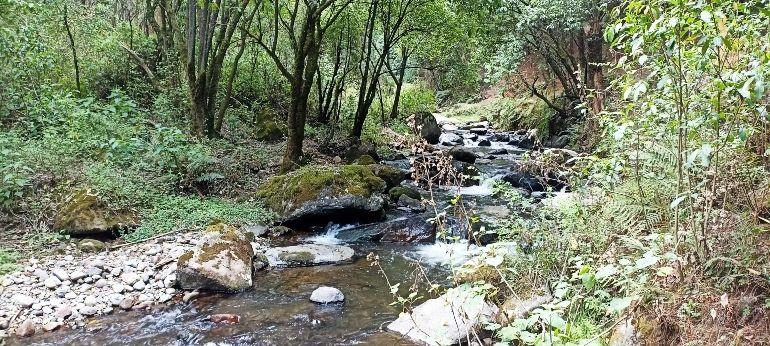The area of La Cañada, in the Magdalena Contreras mayor's office, is the gateway to the Bosque de los Dinamos, one of the most important forest lungs in Mexico City.
For more than 50 years it has been one of the meeting points for the inhabitants of the original town of Magdalena Atlitic. In this green area, sports, cultural and religious activities are carried out.
The 113.46-hectare plot, which was part of the former La Cañada ranch, is now the center of conflict between community members and activists with the company that has owned it since 1968, the real estate company Grupo Frisa.
Carlos Alberto Jacal Téllez is part of the collective 'In Defense of Dynamos', a group of young people who openly oppose the La Cañada National Park project, led by Grupo Frisa, in collaboration with the Secretariat of Environment of Mexico City (Sedema).
“Frisa has her story, where they touch and destroy, and we don't want La Cañada to intervene,” she says in an interview with Journalism Causa Natura, while taking a tour of the area.
La Cañada extends from the edge of the former farm to near the first dynamo, an old electric power generator installed in the forest. (In total there are four and that gives rise to the name, Bosque de los Dinamos). From that point up the mountain there is a communal property that covers a total of 2,393 hectares.

Photo: Alejandro Castro/ Causa Natura
Through this terrain, they cross 2.5 kilometers of the Magdalena River, the only living river in Mexico City.
Carlos assures that accepting the Frisa project is the door to gentrification and real estate hoarding, as has been recorded in the towns of Xoco, in Benito Juárez, or Santa Fé, between Álvaro Obregón and Cuajimalpa.
According to the Urban Development Program of the Magdalena Contreras mayor's office, both land and communal property use Ecological Preservation (PE) land.
In addition, since June 1932, it was declared a Forest Protection Zone, with no changes to that status so far.
José Sacramento, visual artist and community member of Magdalena Atlitic, is also part of the opponents of the project, from the town's Community Assembly.
According to the community member, this is not the first time that an attempt has been made to carry out a project in the area, since he says that in the eighties there were talks with the community to build a golf course.
About three years ago, he said, a group of foreigners began to approach the area to take measurements. He was a staff member of Taller 13, an architecture firm that initially promoted the La Cañada Natural Park project.
The plan published on its website included a water museum, artificial wetlands, temporary market, auditorium and a viewpoint and a camping area with “alpine shelters”.
However, there are currently signs placed in the area where Grupo Frisa separates itself from the Workshop 13 project.
“Grupo Frisa always comes up with this ecological discourse and then they destroy the area they say they are going to rescue. This is what happened in Puerto Aventuras, in Playa Rosarito, what they wanted to do in Tlalpan with Biometrópolis,” said the community member.
One of their concerns is the infrastructure that was presented to them in the initial project, since building it requires a change in land use.
Raúl Alfaro Segovia, Public Relations representative of Grupo Frisa, told Journalism Causa Natura that the initial project of Workshop 13 has been ruled out. “Like everything else, it's a process, some things are being taken away, adding others,” he said.
Alfaro Segovia said that currently only interactive trails are planned. He assured that it is a private park with free public access, through which it will be possible to restore the forest, tidy up trade and prevent further invasions.
“I want to be very emphatic about this, no type of real estate development is contemplated,” he said.
- What does Grupo Frisa gain from the investment it will make for the construction and subsequent operation of the Park? , Alfaro Segovia was questioned.
The company representative replied that actions of this type respond to a global trend and give a good image to the company. He argued that in the 63-year-old company, there is a generational change concerned about the environment.
The La Cañada Natural Park project is led by Daniela Rivera Torres Burillo, daughter of Frisa's owner, Carlos Rivera Torres.
Horacio Bonfil Sánchez, environmental consultant at the head of this initiative, said that the plan is to convert the park into an Area Intended Voluntarily for Conservation (ADVC), a mechanism provided for in the General Law on Ecological Balance and Environmental Protection (Lgeepa).
The biologist also indicated that steps are already being taken to make it happen. He also stated that it is intended to carry out a sanitation program, since there are sick trees.
For Carlos, from the group En Defensa de los Dinamos, the company's word is not enough, as he said that this is not the first time that real estate companies have destroyed forests and wetlands to achieve their economic objectives.

Photo: Alejandro Castro
“They don't give complete information, when they have been questioned about the devastation of Frisa in other developments they don't answer anything. They are only negotiating with traders,” he complained.
At the entrance to La Cañada, informal commerce has spread, which uses river water for its own activities and irrigation of green water. Food services, horseback riding and ATVs, mechanical and sanitary games are offered (although there is no drainage infrastructure).
On July 28, 2021, the representatives of Grupo Frisa, Daniela Rivera Torres and Gilberto Llerena Gutiérrez, signed an agreement with the leaders of the Merchants Committee of La Cañada, Moises Alamilla Mendoza, Zenon Mendoza Acosta and Benito Mendoza Cabañas.
Among the points of the agreement, it is established that the merchants recognize Frisa as the owner of the land. In the same way, it is noted that sellers will continue to carry out their activities for life and generationally.
José Sacramento, of the Magdalena Atlitic Popular Assembly, asserted that although the vendors are part of the town, they do not have the approval of the community.
They are even held responsible for the environmental deterioration of the area.
Raúl Alfaro Segovia, from Frisa, said that current sellers will be allowed to continue, but will no longer be accepted.
Another objective in the project's socialization process are the directors of basic education schools.
According to the company's plan, it seeks to establish a Civil Association for the management and maintenance of the park, through which donations from the private sector can be received.
Frisa also manages the La Cañada equestrian club, which covers an area of 3.96 hectares and is located on the side of the former farm, according to Raúl Alfaro Segovia. This complex is located on a fraction of the land with Ecological Rescue land use, in accordance with the Urban Development Program of the Magdalena Contreras Mayor's Office.
Magdalena River Basin, under siege from human activities
The Magdalena River basin, better known as Los Dinamos, covers an area of 30 square kilometers. The Magdalena River is its main perennial runoff and contributes largely to the surface water supply in Mexico City.
The river enters the urban area until it reaches the Anzaldo dam, from there, it is piped and flows into the collector of Río Churubusco Avenue to Los Viveros de Coyoacán.
For community members, human activity has taken its toll on the forest and the river.
“I've been here my whole life and it's changed a lot. It used to be full, full of trees, now they've run out a lot,” said José Sacramento.
According to the Magdalena River Master Rescue Plan, the area has several deterioration processes.
One of the most significant is the loss of vegetation cover resulting from clandestine logging. Another factor that puts ecosystems at risk are forest fires.
“Various economic activities are taking place in the area, some of which cause strong impacts on the environment. On the one hand, the increase in uncontrolled recreational activities represents a problem, since there are no restrictions on the number of people entering from the lower to the middle part of the basin, which is the most visited area,” the report says.
In addition, it is indicated, there is insufficient surveillance and control over the activities carried out by visitors and the areas they can enter.
Another major problem is the growth of urban sprawl towards Ecological Preservation land. It is estimated that there are at least 12 irregular settlements in the area. The main ones are Sayula and Cazulco, located on the slopes of La Cañada.
These neighborhoods have improvised drainage or electrical energy services, or in many homes they don't. In addition to clearing vegetation to build houses, wastewater and garbage disposal represent another challenge.
The irregular use of land for housing occurs for two main reasons. The first, they are inhabitants to whom land is sold illegally and cheaply. The second is the community members themselves who decide to hoard land for their descendants, without respecting the ecological reserve and without the support of the community.
According to the plan presented by Grupo Frisa, the invasions cover a total of 14.66 hectares of the total land in La Cañada, which represents 13.99 percent of the surface.
Carlos, with his 29 years of life living in the town of Magdalena Atlitic, said that the changes in the ecosystems and ways of life of the community are remarkable.
“It used to be very cheap to rent here, now there are already a lot of big houses owned by people with high purchasing power, little by little they have been moving in. Now, too, the forest is increasingly deteriorated, if we don't take care of it now, then it won't be possible,” he concluded.



Comentarios (0)